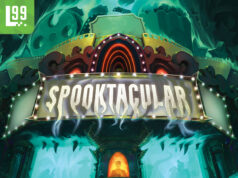Note: This preview uses pre-release components and rules. What you see here may be different from the final, published game. This post was a paid preview, you can find out more information here.
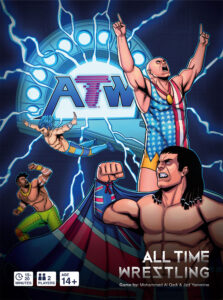 Despite its popularity and seemingly board game friendly elements, professional wrestling has never really had a standout strategy game. Well, All Time Wrestling is looking to change that by offering players a game with both tactical choices and a dash of dice-rolling randomness to ramp up the excitement.
Despite its popularity and seemingly board game friendly elements, professional wrestling has never really had a standout strategy game. Well, All Time Wrestling is looking to change that by offering players a game with both tactical choices and a dash of dice-rolling randomness to ramp up the excitement.
The game comes with eight playable wrestlers, four of which are officially licensed recreations of legendary workers Andre the Giant, “Macho Man” Randy Savage, Kurt Angle, and The British Bulldog.
All Time Wrestling is for one to four players and most individual games take just 20-40 minutes to play. There are also additional rules for various play modes and match types.
Gameplay Overview:
At its core, All Time Wrestling is a hand management combat-style game. Each player takes on the role of a professional wrestler and will use the character’s corresponding dual-layered player board to track their information during the match. Each wrestler has a predetermined starting stamina and health rating, as well as a specialized deck of cards they use. Players start the game with a cultivated hand of five cards. The goal of the game is for players to damage their opponent enough to score a pinfall or submission victory.
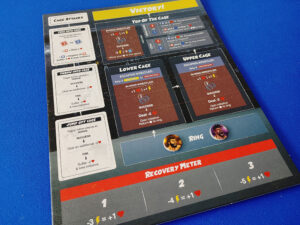
The player whose turn it is has “The Initiative” and they can take one of three actions:
- Draw a new card from their deck and lose the initiative.
- Regain three of their spent stamina points and lose the initiative.
- Play one or more attack cards from their hand.
The first two options are self-explanatory but attacking is the main way the game progresses. Each attack card will cost players a bit of their stamina to play and also includes a target number. The attacking player must roll a die to see if they hit that target number and therefore successfully complete the move.
Before the attacker rolls for the target number, the defender has the option to block. They can use abilities on their player board, some of which can block moves or even counter them (these vary based on which wrestler you are). There are also rules that allow the defending player to stop the attacks if their opponent is attempting multiple low damage attacks consecutively.
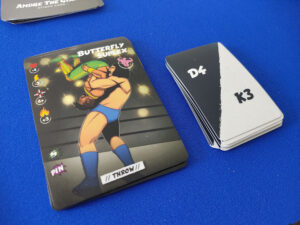
If an attack fails, then the defending wrestler gains the initiative. If an attack is successful, damage will be dealt to their opponent equal to the value shown on the attack card. The attacking player will also gain momentum on The Momentum Meter based on what the move was. This momentum comes into play as the match wears on because having more momentum makes doing higher damage moves easier. Defending players can recoup some stamina or draw a card after they’ve been hit with an attack.
After a successful attack, the attacking player keeps the initiative and plays again by selecting one of the three options. The game also has two different combo systems. Certain attack cards have a symbol that allows them to be played simultaneously while other cards have symbols in their corners that, when linked with an attack card immediately after, will increase damage or make moves easier to complete. (Thematically, this ties into a style of wrestling known as chain wrestling where linking moves together actually increases their effectiveness.)
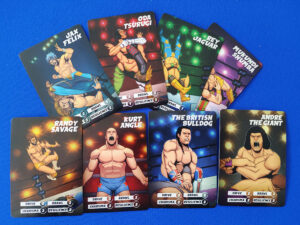
Gameplay will continue like this with players using their special abilities at the right time to make sure they don’t run out of stamina. It’s also important for players to maximize their turns because once a player’s health gets low, it is very difficult to avoid being pinned. On the topic of being pinned (or submitting), certain cards in every wrestler’s deck can lead to a pin, which is most often how the game will end. When an attack with the “pin” keyword is successful, the attacking wrestler has the option to turn it into a pin. The defender will then have to roll two dice in an attempt to kick out. If the combined total of the roll is equal to or less than their current health, then they kick out successfully.
That’s the general idea of All Time Wrestling’s gameplay. There are additional rules for signature and finishing moves such as the fact that they cannot be discarded and almost always lead to a pin attempt. These cards are incredibly powerful but also difficult to achieve earlier in the match and require target number modifiers that are gained when The Momentum Meter is in a player’s favor, or their opponent has been weakened sufficiently.
The game also includes different game modes such as rules to have tag team, cage, and last man standing matches. These modes change some of the rules and in the case of the cage match include a new game board showing the distinct levels of the cage that players can climb on to perform moves and attempt to escape.
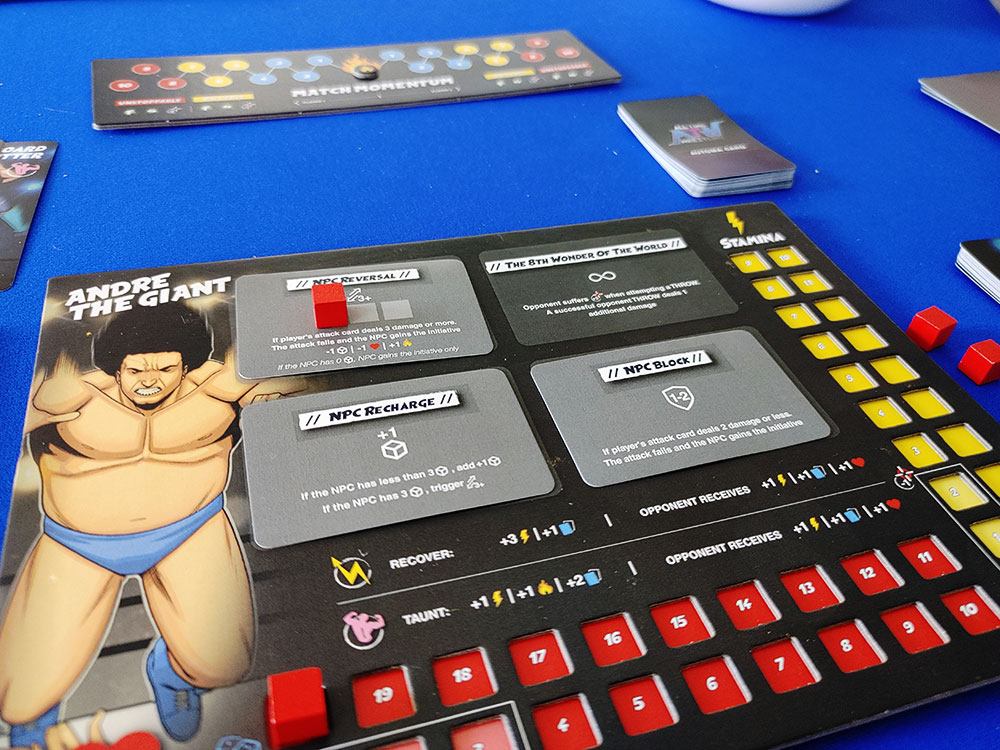
Gameplay Impressions:
In its raw, two-player form, All Time Wrestling is a fast-playing back and forth struggle. Timing your card play effectively will help mitigate poor attack rolls and keep the defender on their toes.
Aside from the standard rules, one of the main draws of the game is its career mode, which is dubbed All or Nothing: Season 1. To play through a career, players will select either Kurt Angle or (one of my childhood favorites) The British Bulldog and follow them through three chapters with a full story and even some branching options that are dependent on choices you make along the way.

I won’t spoil too much about the campaign’s story, but it has an interesting fantasy spin that ties into actual events that occurred in the wrestlers’ lives. The matches you play are mostly similar to the solo single-match experience; the Automa opponents play cards and then have a deck that handles their success or failure rate.
What makes the campaign different is what happens before and after the matches. Just like on a weekly wrestling television show, players will often have the option to perform backstage actions such as cutting promos or doing extra training. A character’s health at the end of matches will also impact the campaign because wrestlers can become injured, thereby hindering their future matches.
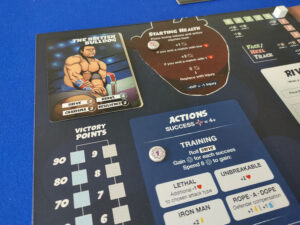
Players can also upgrade their wrestlers by training and even make decisions that will alter the trajectory of how the fans react to them. If you always try to do what’s right, you’ll advance on the Face track. But if you’re feeling a little villainous, you can make questionable decisions and move along the Heel track. Each of these tracks has benefits and complications that change the story and gameplay. (For those not aware: In wrestling, a “babyface” or “face” is the term for the wrestlers fans are meant to cheer for, while “heels” are the ones who are supposed to be booed.)
The campaign is progressed by story cards that will direct you on how to alter the starting condition for the next match and occasionally give you choices about which card to draw next. Each chapter also has a different structure. Without spoiling anything: Chapter 1 is essentially a series of matches, Chapter 2 involves a tournament, and Chapter 3 take things in a unique direction.
Final Thoughts:
All Time Wrestling was clearly designed by fans of professional wrestling. It’s obvious not only in the broad strokes of the game, but also in many of the details like the references to actual wrestling events in the campaign, the look of the licensed characters, and the names of the moves on the attack cards. (And if wrestling marks squint hard enough, they’ll probably even be able to spot which real-life wrestlers inspired some of the game’s fictional characters as well.)
The eight wrestlers each play differently, which gives All Time Wrestling enough variety to be a pickup and play option on game night. But once you add in the other play modes and the solo campaign, its replay value becomes that much more expansive for those who enjoy the gameplay system.
The campaign for All Time Wrestling launches today, so head over to the campaign page to find out all the information including how to back.









